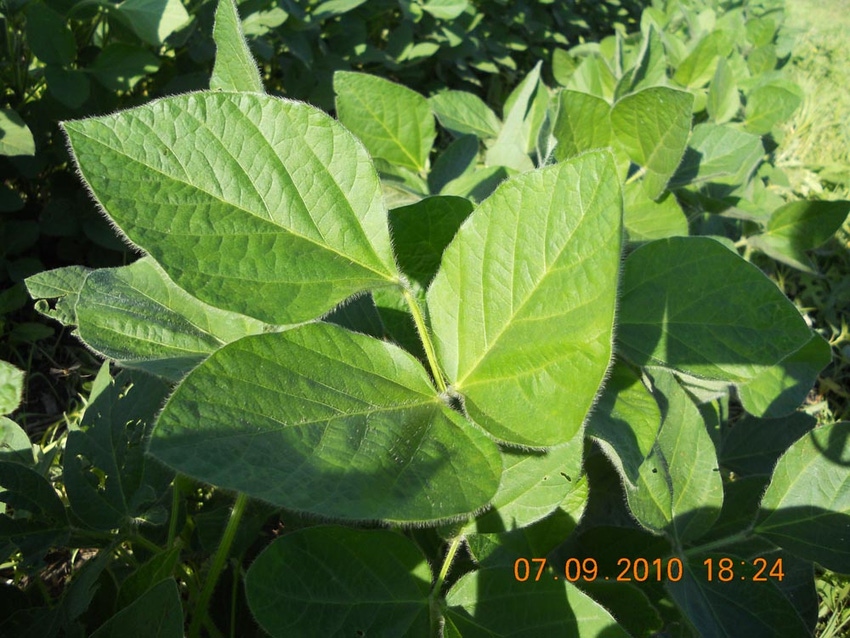July 26, 2011

We have received a number of calls about cupping or wrinkling of soybean leaves, and it seems that this has become an annual issue in much of the Corn Belt. Some of the symptoms are undoubtedly due to drift or volatility of herbicides due to the many windy days this year, but some are due to other problems, as well. A number of factors can cause these symptoms, and it can be difficult to pinpoint the exact cause. Some additional information on this issue follows. There is also a fact sheet with color photos available from the University of Wisconsin, Dicamba Injury to Soybeans.
One of the first herbicides to get blamed in many fields is dicamba, which may have been applied in a nearby cornfield. Products containing dicamba include Banvel, Clarity, Marksman, Celebrity Plus, Northstar, Status, Yukon and numerous generic products. Exposure of soybeans to low concentrations of dicamba through drift or volatility – or even dicamba residues in spray tanks – may be the culprit in some fields. The potential for volatility varies among these products, but all can drift if applied during windy conditions. However, many of the affected fields seem to be far enough away from treated cornfields, or dicamba was not used in the area, and this possibility can be ruled out.
The most typical symptoms from exposure of soybeans to dicamba are puckering of the new leaves that are emerging seven to 10 days after exposure. This may be accompanied by stunting of the plant. Soybeans may show these symptoms on several trifoliates, and then recover completely. Spray particle drift from Distinct and Status application often causes more severe symptoms than dicamba alone, due to the diflufenzopyr component of Distinct. However, there is little risk of volatilization of diflufenzopyr, while dicamba can volatilize readily depending upon formulation and temperature.
Research indicates that soybean yield is not generally reduced when minor symptoms occur, and yield loss is more likely if soybeans are in the reproductive stage at the time of exposure (although still unlikely unless symptoms are severe). Our research with postemergence soybean herbicides indicates that soybeans can tolerate considerable early season injury with little or no impact on yield, when rainfall and other environmental conditions are generally favorable for crop growth after the injury has occurred. Yield loss seems to be most likely when herbicides are applied after about the beginning of July, and soybeans are small at the time of application (which might occur from late planting or poor early season growing conditions). Where this has occurred, soybeans may not recover well enough to attain the size needed for maximum yield potential.
Over the past decade, we have heard reports of and observed fields where leaf puckering or cupping was uniform over the entire field. Other fields have shown symptoms only in some areas. In OSU research plots, we have occasionally observed puckering in Roundup Ready soybeans following application of glyphosate. Spider mites and leafhopper have been known to cause cupping and wrinkling of soybean leaves.
Many of the fields with puckering were previously treated with a postemergence herbicide other than glyphosate. ALS-inhibiting herbicides seem to be most often used in fields with the symptoms, but other herbicides have also been used. One working theory about these symptoms: When the postemergence herbicide causes injury to the terminal buds on soybeans, apical dominance is altered, and plant hormones are redistributed within the plant. The result is the appearance of injury that is similar to that from plant growth regulator herbicides (dicamba, 2,4-D). New shoots may occur at nodes below the injured zone, the plant may take on more of a bushy appearance, and leaves may be wrinkled and cupped. However, most of the fields have not exhibited the increased "bushiness" that might occur if apical dominance was lost.
While herbicides may be responsible for some of the puckering, cupping and wrinkling that has been observed, we suspect that environmental conditions and soybean variety may have a significant role. This is based on the observation of uniform cupping in fields where no postemergence herbicide was used. Some varieties may be more likely to show symptoms than others. We have not been able to come up with a good explanation for this phenomenon. However, the good news is that leaf cupping and wrinkling generally should not affect yields, and soybeans generally compensate well from other herbicide-related problems given enough time and moisture.
You May Also Like




